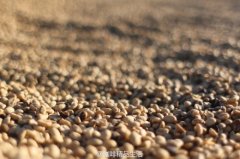The technique of coffee tasting, the skill of tongue tasting coffee.
"Acidity" is often used in coffee tasting or coffee training, which is translated as "acidity" in Chinese. It is often misunderstood as the acidity in acid value or the sour taste of lemon or vinegar. In fact, it is not a concept. Usually coffee people describe coffee flavor refers to "Acidity", is to describe a lively, bright, fresh, refreshing feeling.

Usually, when distinguishing the taste of coffee, the coffee liquid is covered with sour, bitter, sweet and salty taste buds on the tongue, so that a soft sour taste can be felt on both sides of the tongue. Among them, although the coffee is not salty, taste does not need salty taste, but still take the initiative to consciously experience it evenly and carefully, so that we can master the skills to distinguish the different tastes of coffee.
Acidity (acidity) is the most important item in coffee tasting. Without acidity, coffee beans are like lifeless and tasteless.
"Acidity" has many different characteristics, which is an important basis for distinguishing coffee beans from different producing areas, such as coffee from Yemen or East Africa, whose acidity has an impressive fruity aroma or a red wine-like taste, while some from the Central American highlands or the Caribbean often have so-called bright acidity.
Generally speaking, the deeper the coffee beans are roasted, the acidity decreases, but some raw beans with high acidity show more sharp and irritating taste when they are roasted deeply. A batch of beans baked in Papua New Guinea (Papua New Guinea) a few days ago are between City and Full City. Although they have high acidity, they are balanced and have very rich and high-pitched flavor changes. So when it comes to "this acid is not the other acid", I am afraid that Chinese friends drink too much Nestle instant, and are afraid of the strong sour taste, mistakenly thinking that it is the acidity described by what we call fresh coffee!
Important Notice :
前街咖啡 FrontStreet Coffee has moved to new addredd:
FrontStreet Coffee Address: 315,Donghua East Road,GuangZhou
Tel:020 38364473
- Prev

Coffee beans Coffee training Knowledge Coffee beans Grinding
Coffee beans, those dark brown beans seem ordinary, but there are a lot of knowledge at all stages. The ideal time to grind coffee is before it is cooked. Because ground coffee is easy to oxidize and lose flavor, especially in the absence of proper storage, coffee powder is also easy to change flavor, naturally unable to cook a fragrant coffee. Some people are afraid of trouble or don't want to.
- Next

The process of basic knowledge of coffee beans from fruit to coffee bean
Coffee training basics-from fruit to raw coffee beans: a coffee tree can harvest 3-5 kilograms of fruit, and raw coffee beans account for 5% of the fruit quality. Going from fruit to raw coffee beans is really a time-consuming and laborious task. Arabica and Robusta Arabica coffee account for about 2% of the world's coffee production. The plant is not suitable for high temperature, low temperature, more rain and less rain.
Related
- What is the meaning of lactic acid fermentation with coffee bean treatment?
- How to judge the state of foam by sound?
- How does the latte pull out the unicorn pattern? Come to get for a little trick to improve the flower pull!
- Will flower pulling affect the taste of the latte?
- Do you know the history of coffee?
- The difference between honey treatment and sun washing what is raisin honey treatment?
- What kind of milk can a novice use to make coffee foam to keep the foam longer? The correct method and skills of milking tutorial sharing
- Why do washed coffee beans taste sour? Flavor characteristics of washed Coffee
- Introduction to the skill of how to practice the size and height of water injection around the circle of hand-brewed coffee
- How do beginners practice coffee flower drawing from scratch?

